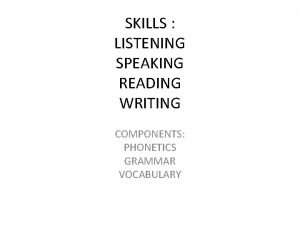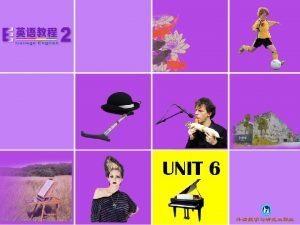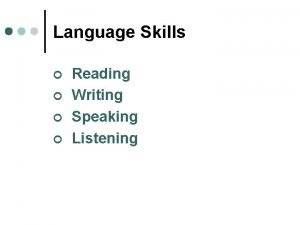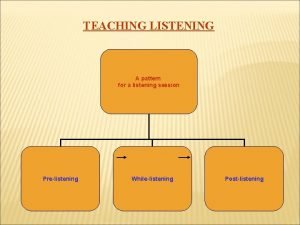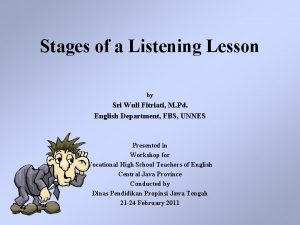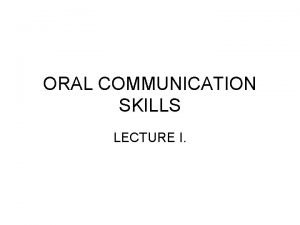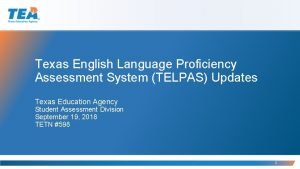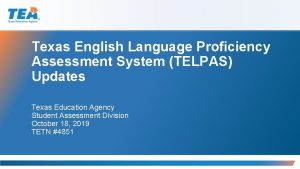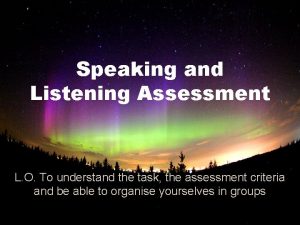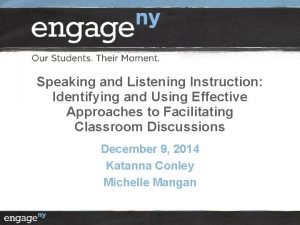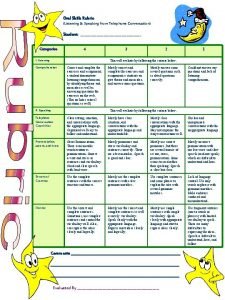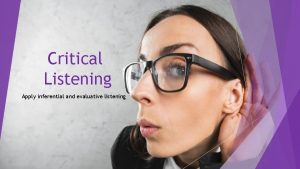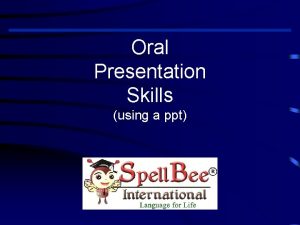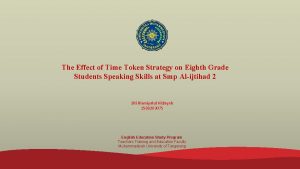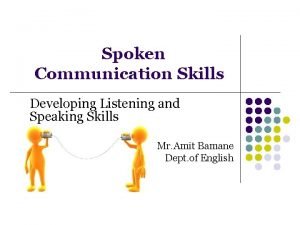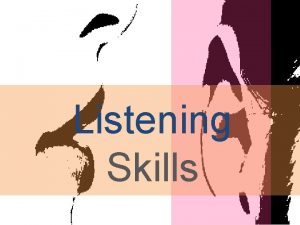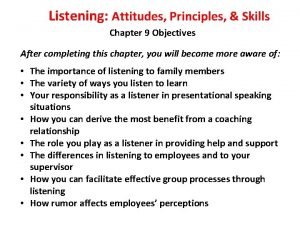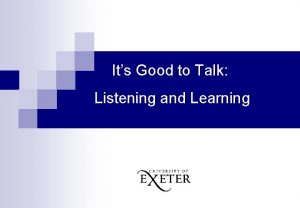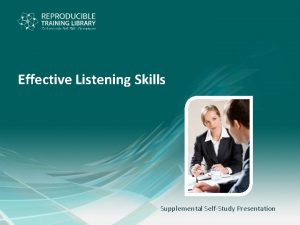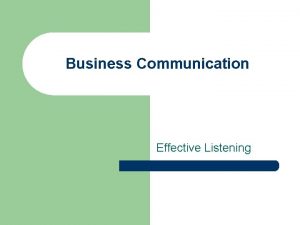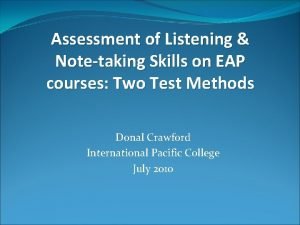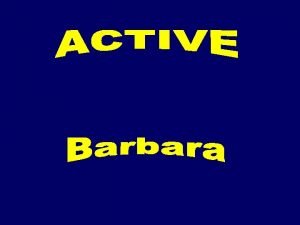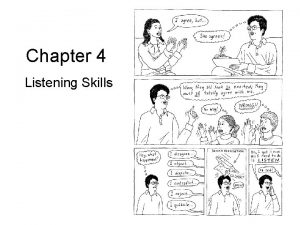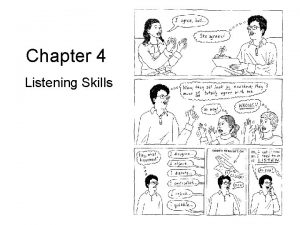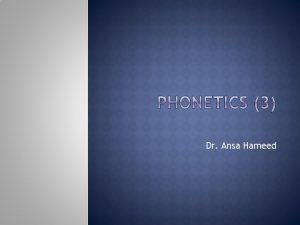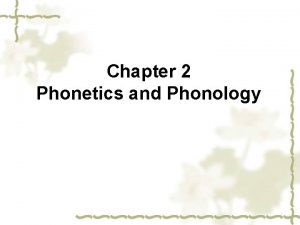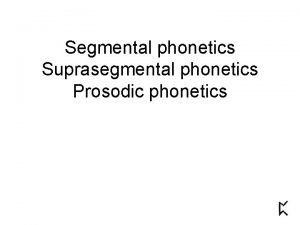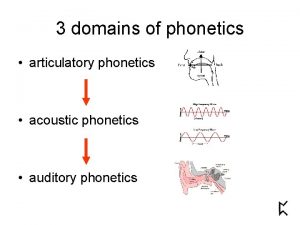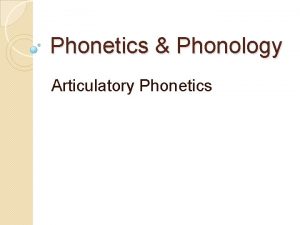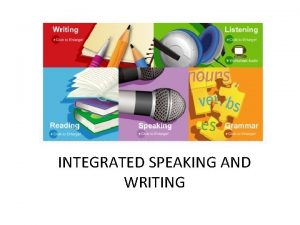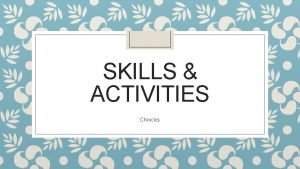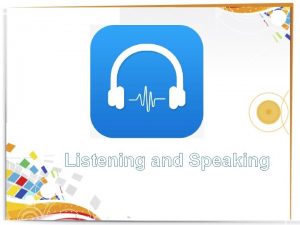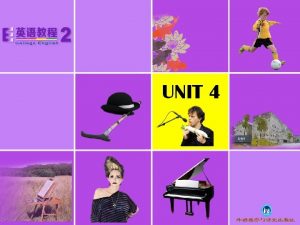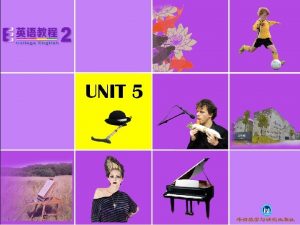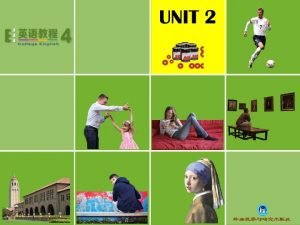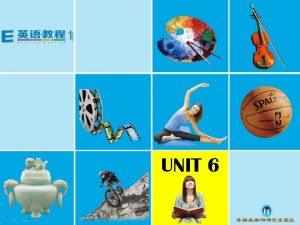SKILLS LISTENING SPEAKING READING WRITING COMPONENTS PHONETICS GRAMMAR



































- Slides: 35

SKILLS : LISTENING SPEAKING READING WRITING COMPONENTS: PHONETICS GRAMMAR VOCABULARY

TEACHING LISTENING

Good listening lessons go beyond the listening task itself with related activities before and after the listening.

Before Listening 1. introducing the topic 2. finding out what they already know about it. How? a. brainstorming session b. some discussion questions related to the topic. c. Then provide any necessary background information and new vocabulary students will need for the listening activity.

During Listening 1. Be specific about what students need to listen for. 2. They can listen for selective details or general content, or for an emotional tone such as happy, surprised, or angry. 3. If they are not marking answers or otherwise responding while listening, tell them ahead of time what will be required afterward.

After Listening 1. Finish with an activity to extend the topic 2. help students remember new vocabulary items. >> This could be a discussion group, craft project, writing task, game, etc.

The following ideas will help make your listening activities successful. Noise Reduce distractions and noise during the listening segment. You may need to close doors or windows or ask children in the room to be quiet for a few minutes. Equipment If you are using a cassette player, make sure it produces acceptable sound quality. A counter on the machine will aid tremendously in cueing up tapes. Bring extra batteries or an extension cord with you. Repetition Read or play the text a total of 2 -3 times. Tell students in advance you will repeat it. This will reduce their anxiety about not catching it all the first time. You can also ask them to listen for different information each time through.

Content Unless your text is merely a list of items, talk about the content as well as specific language used. The material should be interesting and appropriate for your class level in topic, speed, and vocabulary. You may need to explain reductions (like 'gonna' for 'going to') and fillers (like 'um' or 'uh-huh'). Recording Your Own Tape Write appropriate text (or use something from your textbook) and have another English speaker read it onto tape. Copy the recording three times so you don't need to rewind. The reader should not simply read three times, because students want to hear exact repetition of the pronunciation, intonation, and pace, not just the words.

Video You can play a video clip with the sound off and ask students to make predictions about what dialog is taking place. Then play it again with sound and discuss why they were right or wrong in their predictions. You can also play the sound without the video first, and show the video after students have guessed what is going on. Homework Give students a listening task to do between classes. Encourage them to listen to public announcements in airports, bus stations, supermarkets, etc. and try to write down what they heard. Tell them the telephone number of a cinema and ask them to write down the playing times of a specific movie. Give them a tape recording of yourself with questions, dictation, or a worksheet to complete.

TEACHING SPEAKING

personalities play a large role in determining the goal of speaking 1. risk-takers unafraid of making mistakes will generally be more talkative, but with many errors that could become hard-to-break habits >Quantity 2. Conservative, shy students may take a long time to speak confidently, but when they do, their English often contains fewer errors and they will be proud of their English ability > Quality

Here are some ideas to keep in mind as you plan your speaking activities. Content As much as possible, the content should be practical and usable in reallife situations. Avoid too much new vocabulary or grammar, and focus on speaking with the language the students have. Correcting Errors You need to provide appropriate feedback and correction, but don't interrupt the flow of communication. Take notes while pairs or groups are talking and address problems to the class after the activity without embarrassing the student who made the error. You can write the error on the board and ask who can correct it.

Quantity vs. Quality Address both interactive fluency and accuracy, striving foremost for communication. Get to know each learner's personality and encourage the quieter ones to take more risks. Conversation Strategies Encourage strategies like asking for clarification, paraphrasing, gestures, and initiating ('hey, ' 'so, ' 'by the way'). Teacher Intervention If a speaking activity loses steam, you may need to jump into a role-play, ask more discussion questions, clarify your instructions, or stop an activity that is too difficult or boring.

Three-Phase Activities Pre-Activities During Activities Post-Activities

TEACHING READING IS A GUESSING GAME!

Consider the following when designing your reading lessons. Purpose Your students need to understand ahead of time why they are reading the material you have chosen.

Reading Strategies Prediction: This is perhaps the most important strategy. Give your students hints by asking them questions about the cover, pictures, headlines, or format of the text to help them predict what they will find when they read it. Guessing From Context: Guide your students to look at contextual information outside or within the text. If students have trouble understanding a particular word or sentence, encourage them to look at the context to try to figure it out. Advanced students may also be able to guess cultural references and implied meanings by considering context.

Skimming: The idea of skimming is to look over the entire text quickly to get the basic idea. For example, you can give your students 30 seconds to skim the text and tell you the main topic, purpose, or idea. Then they will have a framework to understand the reading when they work through it more carefully. Scanning: Students must look through a text quickly, searching for specific information. Ask your students for a very specific piece of information and give them just enough time to find it without allowing so much time that they will simply read through the entire text.

Silent Reading vs. Reading Aloud Reading aloud may be useful for reporting information or improving pronunciation, but a reading lesson should focus on silent reading. When students read silently, they can vary their pace and concentrate on understanding more difficult portions of the text. They will generally think more deeply about the content and have greater comprehension when reading silently.

Three-Phase Activities Pre-Activities During Activities Post-Activities

TEACHING WRITING

Consider the following ideas for writing Types of Tasks Imitating a model Filling in blanks in sentences or paragraphs Summarizing a story text or videos

Format Clarify the format. For an essay, you may specify that you want an introduction, main ideas, support, and a conclusion. For a poem, story, list, etc. , the format will vary accordingly, but make sure your students know what you expect. Model Provide a model of the type of writing you want your students to do, especially for beginners.

Correction Minimize threatening appearance of correction. Instead of a red pen, use green or blue or even pencil, as long as it's different from what the student used. Explain to the students that you will use certain symbols such as VT for verb tense or WO for word order, and be very clear whether a mark (check mark, X, star, circle) means correct or incorrect as this varies among cultures.

Process of Writing 1. 2. 3. 4. 5. Pre-writing Drafting Revising Writing final draft publishing

Teaching Pronunciation

TEACHING PHONETICS

Pronunciation involves far more than individual sounds. 1. Word stress 2. sentence stress 3. intonation 4. word linking all influence the sound of spoken English

TEACHING GRAMMAR Grammar is often named as a subject difficult to teach. Its technical language and complex rules can be intimidating

Consider the following as you integrate grammar into your lessons. Acknowledge your role. As a volunteer, you aren't expected to be a grammar expert. You may have difficulty explaining the 'why' behind grammar points, but you can recognize 'right' and 'wrong' wording and your students will still benefit from your English sensibility.

Find good lesson plans. It's difficult to make a good grammar lesson from scratch, so any searching you do for appropriate grammar lessons in textbooks or on the Internet will be time well spent.

Use meaningful texts. The sentences you use to teach and practice grammar shouldn't be random. Choose material that is relevant. For example, if your learners are preparing for citizenship or need workplace English, use these contexts to create appropriate examples. If possible, bring in real-life, authentic texts to illustrate your points.

Teach basic grammar words. Although you need not be fluent in grammar jargon, it's a good idea to teach at least some vocabulary (noun, verb, past tense, etc. ) to assist you in your explanations.

TEACHING VOCABULARY

Thank You
 Listening speaking reading writing are the components in
Listening speaking reading writing are the components in Grammar listening speaking reading writing
Grammar listening speaking reading writing Grammar listening speaking reading writing
Grammar listening speaking reading writing Language skills reading writing speaking listening
Language skills reading writing speaking listening Pre listening while-listening and post listening examples
Pre listening while-listening and post listening examples Pre listening stage
Pre listening stage Conclusion for communication
Conclusion for communication Receptive skills listening and reading
Receptive skills listening and reading Pre reading while reading and post reading activities
Pre reading while reading and post reading activities Telpas writing rubric
Telpas writing rubric Telpas rubric
Telpas rubric Speaking and listening assessment
Speaking and listening assessment Listening
Listening Speaking and listening: effective group discussions
Speaking and listening: effective group discussions Rubrics for listening skills
Rubrics for listening skills Action plan for listening skills
Action plan for listening skills Active and passive listening
Active and passive listening Evaluative listening definition
Evaluative listening definition How to convert right linear grammar to left linear grammar
How to convert right linear grammar to left linear grammar Traditional grammar vs modern linguistics
Traditional grammar vs modern linguistics Types of grammar
Types of grammar Right linear grammar to left linear grammar
Right linear grammar to left linear grammar Speaking skills ppt
Speaking skills ppt Objectives for speaking skills
Objectives for speaking skills Speaking skills definition
Speaking skills definition Lesia lam
Lesia lam Total communication process
Total communication process Testing listening
Testing listening Listening skills objectives
Listening skills objectives Objectives of listening
Objectives of listening Listening aims
Listening aims Presentation on listening skills
Presentation on listening skills Types of ineffective listening
Types of ineffective listening Listening and notetaking skills
Listening and notetaking skills Objective of effective listening
Objective of effective listening Success criteria for listening skills
Success criteria for listening skills
